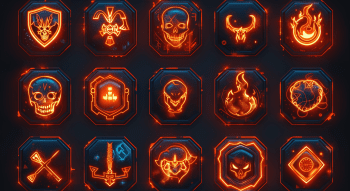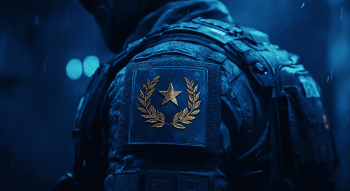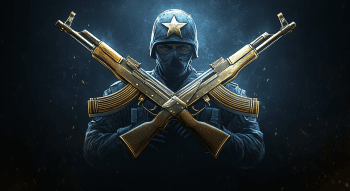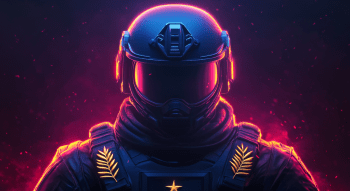CS2 FACEIT Levels & Ranks
Contents
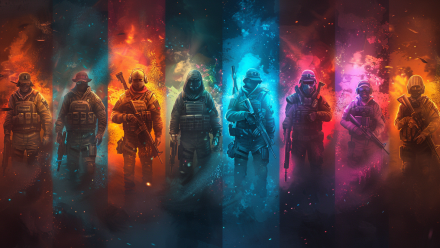
Once you start diving deeper into the world of competitive Counter-Strike 2, you’ll surely meet someone trying to boost their FACEIT level. So, why should players switch to this ranking system, and what are its key differences from the traditional CS2 ranks?
In our comprehensive breakdown, we’ll review all the benefits and drawbacks of using this popular platform. Moreover, we’ll also compare FACEIT levels to CS2 ranks to discover which one estimates players’ performance and skills more precisely.
How Does the FACEIT Rating System Work?
Having one of the highest FACEIT ELO ranks has always been a sign of mastery, even among professional players. The platform continually fine-tunes its algorithms to ensure better gradation of its users. If you aspire to become a professional player like ropz or s1mple, understanding the FACEIT system can help you achieve this goal faster.
FACEIT ELO System
The ELO system is one of the most effective approaches used to compare and measure players’ ratings and skills, and FACEIT utilizes it exceptionally well. When two players with similar ratings face off, the loser drops the same number of points as the winner gains. However, things get more interesting with different rankings:
- If the winner of the matchup has more points, they gain fewer points, while the defeated player loses fewer points.
- If the winner has a lower rating, they gain more points, while the defeated opponent loses more points.
FACEIT Ranks and Levels
Every player on the platform has a particular point range from 1 to 4,000+, which changes after every game based on the outcome. There are also 10 FACEIT levels plus the Challenger status, which represents the elite players. Each user has a specific number of points corresponding to one of the levels with a distinct icon, making it easy to determine a player's approximate level at a glance.
Influence of Individual Stats
The FACEIT ranking system also considers an individual's impact on the match result and adjusts the amount of points given. Thus, a strong performance (positive kill/death ratio, many assists, high KAST, etc.) in a losing match results in fewer points being deducted. Conversely, poor performance in a winning match carried by their teammates leads to a slower rank boost.
What are the Ranks on CS2 FACEIT?
The FACEIT ranks are grouped into 10 diverse levels, plus the Challenger status. Here's the point distribution across levels:
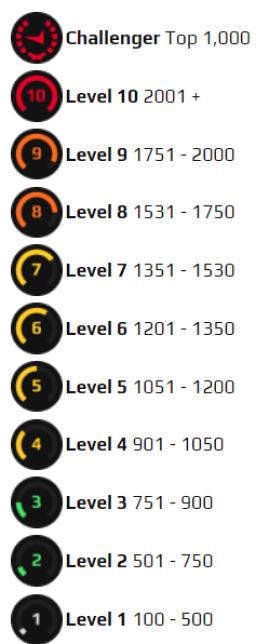
The Challenger rank deserves special mention as it’s awarded to the top 1,000 players in each of the five regions (EU, NA, SA, SEA, and OCE) for their exceptional level of play. Many Challengers are already professional players who use the platform for individual training and playing with friends. However, anyone can achieve this top rank. As the Challenger level depends on the region, it typically requires around 3,100 points in the EU or 2,100 points in the OCE region.
Tools to Track Your Progress
Before we move forward to comparing FACEIT level to CS2 rank, let’s look at how you can check your current ELO points. All in all, there are two popular methods described below.
FACEIT Profile Page Dashboard
You can find all the detailed info about your FACEIT rankings right on the platform. Simply take these steps:
- Log in to your FACEIT account.
- Go to the “Stats” tab.
- Review all the detailed statistics, including your FACEIT level and ELO points.
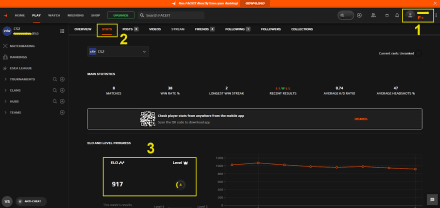
Third-Party Tracking Platforms
You can also use various platforms to find out your ELO points, so you can compare your FACEIT level to your Premier rank. Here is a short list of the most popular services:
How to Earn FACEIT ELO Points?
The ELO points directly reflect your skill and can be earned only when playing the game via the platform. At the same time, understanding FACEIT ranks and how they work can help you climb faster.
For example, defeating stronger opponents and performing well individually will bring you more ELO points. In practice, this means playing with friends who have higher ranks. It’s also wise to start matches only after a proper warm-up.
Difficulties of Switching From Premier to FACEIT
Switching from Premier to FACEIT is straightforward, with an initial calibration. Every new FACEIT player starts with 1,000 ELO points, and if your real level is much higher or lower, you’ll need to play several matches to find equal opponents.
However, when comparing CS2 Premier vs FACEIT, we should mention several serious advantages of this popular platform over the traditional Counter-Strike system:
- Effective Anti-Cheat: Enjoy a fair competition on FACEIT that works better than Valve’s outdated VAC, which has shown little improvement in recent years.
- More Friendly Community: FACEIT servers are much better controlled, reducing toxic communication compared to Counter-Strike 2.
- Advanced Servers: FACEIT servers offer a more pleasant gaming experience thanks to better stability, which is a significant advantage for players from remote regions.
Nonetheless, playing FACEIT won’t earn you free weekly drops available in Premier and other matchmaking modes. Luckily, you can buy one of the subscriptions with regular quests and earn fair rewards, including valuable skins.
FACEIT Level Compared to Premier Mode
First of all, consider that there is no official correlation between FACEIT levels and CS2 Premier ranks. Nonetheless, we’ve managed to come up with a rough comparison of these two metrics:
CS2 Premier Rank | FACEIT Level | Player’s Description |
Silver–Gold Nova I (under 5,000) | Levels 1–3 (100-900) | Beginners and average FPS players. |
Gold Nova II–Master Guardian Elite (5,000-13,000) | Levels 4–7 (901–1,530) | Gamers who have already learned in-game basics, popular tactics, and nade lineups. |
Distinguished Master Guardian–Legendary Eagle Master (13,000-16,000) | Levels 8–9 (1,531–2,000) | Players whose skills, strategic thinking, and reaction times are close to professional standards. |
SMFC–Global Elite (over 16,000) | Level 10 to Challenger | Elite professionals, who often take part in tournaments. |
These comparisons are approximate and depend on factors such as the region, the player's hardware, and playing frequency. Moreover, both FACEIT and Valve update their ELO systems regularly, which can change these proportions.
Also, it’s important to note that one of the biggest advantages of FACEIT ELO levels is their positive impact on matchmaking (compared to the traditional in-game system). Ideally, all players in the matchup are from the same level group, ensuring fair competition. However, if a team has diverse levels, FACEIT balances matchmaking based on the average ELO level.
For instance, if your team consists of two 4-level players, one level-7, one level-8, and a newbie at level-2, you’ll face a team of level-5 opponents +/- 1 level. After the match, the victory of the first team will bring only a few points to the level-7 and level-8 participants, but those of the level-4 will gain more than 10 points. The level-2 player can even receive up to 20 points. This flexible approach allows the system to find games faster, eliminating the need to wait until ten players of the same level are available.
***
After a comprehensive comparison of FACEIT to premier ranks, we can say for sure that if you’re dreaming of a pro scene, you definitely need to opt for this platform. Although it won’t immediately provide you with a significant advantage, you’ll get a more detailed system for tracking your in-game progress. You’ll know exactly what your strengths and weaknesses are, so you can regularly improve your performance.
Additionally, unlike the Premier system, FACEIT places greater emphasis on your individual performance. It minimizes the loss of ELO points if you occasionally play with inadequate teammates. Combine these benefits with stable servers and a strong community, and you’ll get one of the best platforms available for Counter-Strike 2 players.
